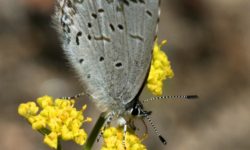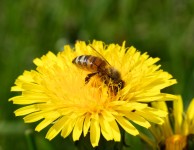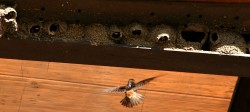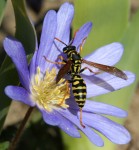Who pollinates flowers in high mountain meadows? Who might be the first to visit your flowers in the morning? Who might be pollinating flowers when it is too cold for other insects?
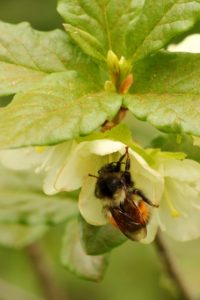
Bumblebees!
With a large “furry” body, bumblebees can live in places other bees cannot and fly when other bees cannot. Compared to other insects, bumblebees have a low surface area to volume ratio which conserves body heat. Therefore, they can fly when it is too cloudy or too cold for most other insects to fly.
The ability to fly in cooler temperatures allows bumblebees to live in cooler regions such as high alpine areas, coastal plains, boreal forests and arctic tundra. Bumblebees can also survive the freezing temperates of these areas in winter.
Unlike honeybees, only the queen bumblebee overwinters. In the fall, she finds a small cavity to nest in (like a rotting log) or excavates her own cavity in the ground to spend the winter. In the spring, she will emerge from her hibernaculum and look for a nesting site.
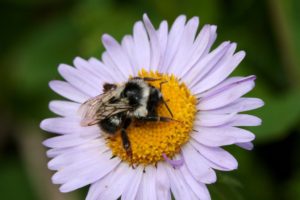
Since bumblebees can fly in cooler temperatures, the queens will search for the first spring flowers. This first pollen will sustain the queen and her first brood until they are able to forage for pollen and bring it back to the nest.
Bumblebees only need to produce enough honey to sustain the nest through the fall since only the queen overwinters. Worker bumblebees collect pollen and nectar to bring back to the larval bees in the nest. Nectar is collected for carbohydrates and pollen is collected as protein for the larvae.
Nests can range from under 50 to 1,000 bumblebees and is dependent on the flowers available in the area. Bumblebees are considered generalist foragers because they feed on a wide assortment of flowers for pollen and nectar.
Since the honey bee population is declining, the role of the bumblebee as a generalist pollinator is very important for native plants and even vegetable, fruit and seed crops.
Bumblebees can release large amounts of pollen when visiting flowers by utilizing “buzz pollination”. The bumblebee holds the flower in its jaw and then vibrates its wing muscles so the wings beat over 130 times per second to shake the flower. Being able to beat their wings that fast also helps generate heat to fly in cooler temperatures.
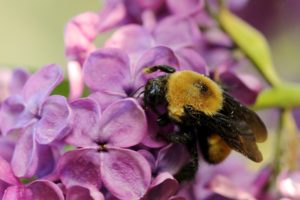
The stinger is barbless so they can sting multiple times.
The bumblebee’s adaptations to fly when and where other bees cannot provides a unique situation for them. Bumblebee diversity actually increases at higher latitudes and altitudes which is opposite of most plant and vertebrate groups that decrease in diversity with latitude.
In North America, 46 species of bumblebees occupy habitats from subtropical to boreal to arctic and high alpine. Identification can be started with the color pattern but variations within species require an up-close look. For an identification guide to Pacific Northwest bumblebees check out this website.
Next time a bumblebee visits my flowers early in the morning on a cloudy day, I’ll be thankful these furry bees can fly when others cannot.
References:
Koch, J., Strange, J., & Williams, P. (2012). Bumble Bees of the Western United States. Retrieved from https://www.fs.fed.us/wildflowers/pollinators/documents/BumbleBeeGuideWestern2012.pdf
Schweitzer, D.F., N.A. Capuano, B.E. Young & S.R. Colla. 2012. Conservation and management of North American bumble bees. NatureServe, Arlington, Virginia and USDA Forest Service, Washington, D.C.
Tangley, L. (2014, April 26). 5 Facts about bumble bees- and how to help them [Blog post]. Retrieved from https://blog.nwf.org/2014/04/5-facts-about-bumble-bees-and-how-to-help-them

